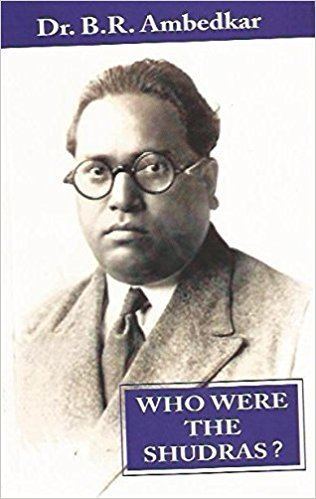9 /10 1 Votes
Originally published 1946 | 4.5/5 Goodreads | |||||||||||||||||||||||||||||||||
 | ||||||||||||||||||||||||||||||||||
Similar B R Ambedkar books, Other books | ||||||||||||||||||||||||||||||||||
Who Were the Shudras? is a history book written by Indian social reformer and polymath Dr. B.R. Ambedkar. The book discusses the origin of the Shudra Varna. B.R. Ambedkar dedicated the book to Mahatma Jyotiba Phule (1827–1890).
Contents
Subject of the book
In the book Dr. Babasaheb Ambedkar, citing Rigveda, Mahabharata and other ancient vedic scriptures, estimates that the Shudras were originally Aryans. They were a part of the Kshatriya Varna belonging to the Solar race (Suryavansha).
Ambedkar writes in the preface of the book,
"Undoubtedly the conclusions which I have reached as a result of my investigations. Two questions are raised in this book: (1) Who were the Shudras? and (2) How they came to be the fourth Varna of the Indo-Aryan society? My answers to them are summarised below.
- The Shudras were one of the Aryan communities of the Solar race.
- There was a time when the Aryan society recognised only three Varnas, namely. Brahmins, Kshatriyas and Vaishyas.
- The Shudras did not form a separate Varna. They ranked as part of the Kshatriya Varna in the Indo-Aryan society.
- There was a continuous feud between the Shudra kings and the Brahmins in which the Brahmins were subjected to many tyrannies and indignities.
- As a result of the hatred towards the Shudras generated by their tyrannies and oppressions, the Brahmins refused to perform the Upanayana of the Shudras.
- Owing to the denial of Upanayana, the Shudras who were Kshatriyas became socially degraded, fell below the rank of the Vaishyas and thus came to form the fourth Varna."
Importantly, Ambedkar states that the Shudras of Hindu society are entirely different from Shudras of ancient Indo-Aryan Society. He writes,
"...Such an inference is without any foundation, for the Shudras of the Indo-Aryan Society are absolutely different in race from the Shudras of the Hindu Society. The Shudras of the Hindu Society are not the racial descendants of the Shudras of the Indo-Aryan Society. This confusion has arisen because of the failure to realise that the meaning of the word 'Shudras' in the Indo-Aryan society is quite different from the meaning it has in the Hindu society. In the Indo-Aryans the word Shudra was proper name of one single people. It was the name of a people who belonged to a particular race. The word Shudra, as used in the Hindu society, is not a proper name at all. It is an epithet for a low uncultured class of people. It is a general cognomen of a miscellaneous and heterogeneous collection of tribes and groups, who have nothing in common except that they happen to be on a lower plane of culture. It is wrong to call them by the name Shudras. They have very little to do with their namesakes of the Aryan society, who had offended the Brahmins. It is a pity that these innocent and backward people of later days have been rolled up with the original Shudras and subjected to the same penalties for which they had given no cause."
Dr. Ambedkar also discusses Aryan race theory and Indo-Aryan migration theory in the book.
Contents
Preface
Part I
- Chapter I - The Riddle of the Shudras
- Chapter II - The Brahmanic Theory of the Origin of the Shudras
- Chapter III - The Brahmanic Theory of the Status of the Shudras
- Chapter IV - Shudras Versus Aryans
- Chapter V - Aryans Against Aryans
- Chapter VI - Shudras And Dasas
Part II
- Chapter VII - The Shudras were Kshatriyas
- Chapter VIII - The Number of Varnas, Three or Four?
- Chapter IX - Brahmins Versus Shudras
- Chapter X - The Degradation of the Shudras
- Chapter XI - The Story of Reconciliation
- Chapter XII - The Theory in the Crucible
